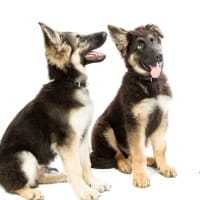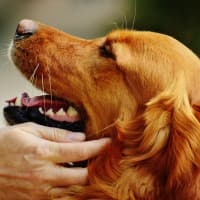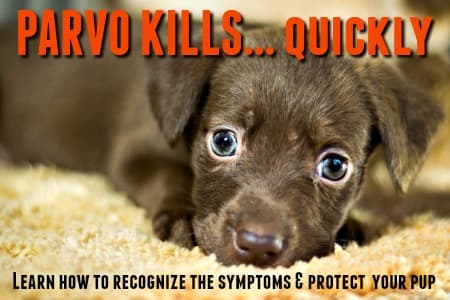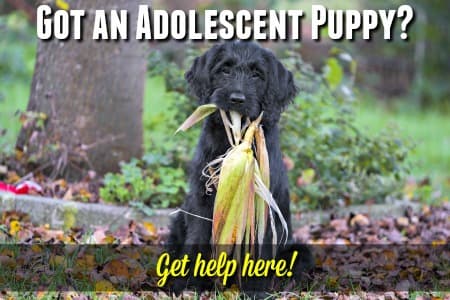FYI: If you buy something through a link on this site I may earn a commission - at NO extra cost to you.
How To Understand Your Dog
Learning how to understand your dog, and what he's trying to tell you, is a learning curve for new owners.
Although love doesn't always need words, you and Fido don't speak the same language, and this can make understanding your dog a little tricky at times.
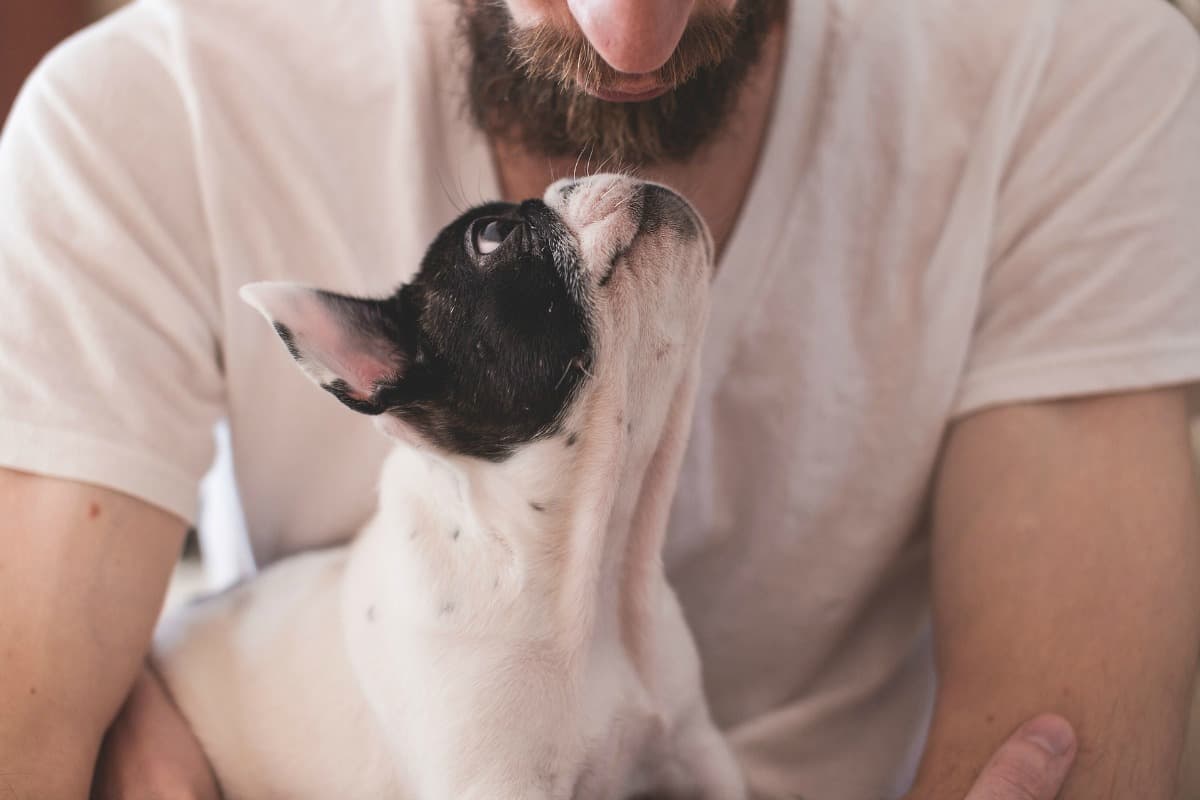
Most times mis-communications are simply confusing, frustrating or even funny. But sometimes they can be at the root of serious behavior or training problems which make life difficult for everyone, and could even put both of you at risk.
Canine communication and behavior is a huge topic and there's a whole lot we still don't know about how and why dogs do certain things, or behave in certain ways.
On this page I'm going to take a closer look at what we do know and hope that it will help strengthen the bond between you and your dog, and limit feelings of frustration or confusion
Quick Links:
- Canine Body Language - Who Needs Words?
- Speaking Dog - Vocalizations & What They Mean
- Actions Speak Volumes - What You're Telling Your Dog
How to Understand Your Dog's Body Language
Our dogs can't tell us what they think, feel or need in a verbal way. So it's important to learn how to understand your dog when he uses non-verbal communication (ie body language).
Good communication is a key part of a healthy relationship, whether it's with our spouse, kids, or pets!
Sometimes our dogs can be trying to say one thing, and we hear/see something different because we're misinterpreting them. As Fido will use his body to let you know what he wants, or how he's feeling, it's vital to learn to 'read' his cues.
The muzzle, eyes, ears and tail are the main indicators of a dog's emotional state and he often also uses body positions and actions to help you figure out what he's trying to say or what mood he's in.
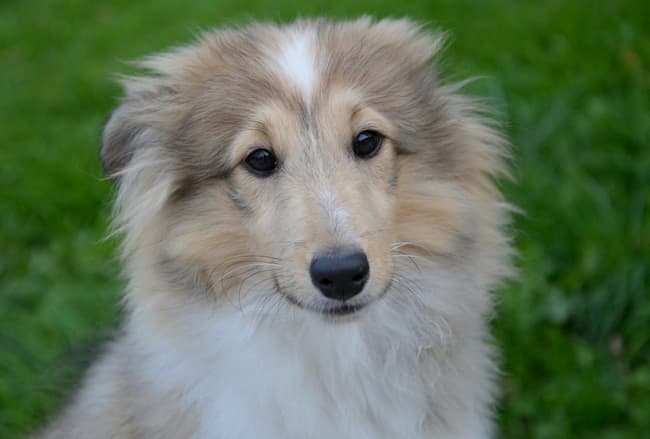
Happy, Friendly or Playful
Tail:
- Almost always horizontal or above.
- Relaxed
- Waving or wagging gently
- Upright and wagging fast
Ears:
- Perked up, opening forward
- Half upright, opening forward
Eyes:
- Bright
- Relaxed eye contact
Head/Face:
- Held high
- Head may be slightly tilted
- Held horizontal, stretching forward
- He may 'smile' - lips are pulled back showing a little teeth (but no gums)
Body:
- Standing up tall
- Showing a play-bow (front legs stretched forward, head down, butt in the air!)
- Leaning forward
- Jumping or 'dancing' on hind legs
Worried or Anxious
Tail:
- Horizontal but still
- Horizontal but with lowered tip
- Below horizontal, wagging gently
- Tucked between legs
Ears:
- Half upright, opening to the side
- Low, opening down or to the side
Eyes:
- Downcast or 'shifty' gaze
- No eye contact
- Peering up through eyebrows
Head/Face:
- Held horizontal or lower
- Head may be tilted right over sideways, with one side of muzzle upwards
Body:
- Lowered body position - head/shoulders 'ducked'
- Crouching
- Pulling backwards or away from person or other dog
Combative or Aggressive
Tail:
- Almost always horizontal or above
- Stiff and straight
- Still/motionless
- Wagging in short, stiff movements
Eyes:
- Direct eye contact (ie a 'stare')
Ears:
- High, erect, opening forward
- Pinned back
Head:
- Held high, neck may be slightly arched
- Head and neck held stiffly horizontal, reaching forward
- Lips may be drawn back, showing teeth and gums
- Muzzle will have lots of deep wrinkles
Body:
- Standing straight up, almost on tiptoes
- Leaning forward, with neck arched or extended
- Stiff body posture
- Hackles will be raised (the hair along the back of his neck and body)
Submissive or Overly Fearful
Tail:
- Held very low or between the legs
- Still/motionless
- May wag the tip
Eyes:
- Downcast/intermittent eye contact
- No eye contact
Ears:
- Held low, opening down
- Pinned back
Head:
- Held horizontal or lower
- Nose may be pointed down or towards chest
- Body might be curved, tail towards muzzle
- Might lick his lips
Body:
- Body kept low to the ground with head and tail 'tucked'
- Curled body shape or crouching
- Lying down, belly exposed
These are generalizations and not ALL dogs will exhibit the same body language, clues or postures when they're happy, scared, or angry.
But most dogs will show at least a couple of them.
Of course there are also a whole range of emotions that fall in between the four given above.
A dog can be cautious, confident, watchful, curious, wary.... and he'll show all of these emotions through body language combining some of the postures and facial expressions I've described.
Here are photos of just a few of the many possible combinations of dog body language clues, and what they mean......
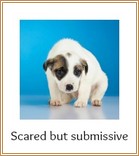 |
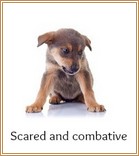 |
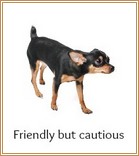 |
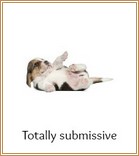 |
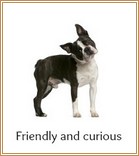 |
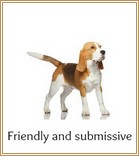 |
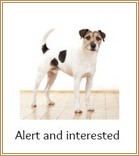 |
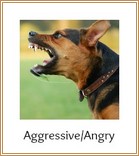 |
If you trust your instincts you'll generally be pretty accurate in your assessment of a dogs emotions.
This is because just as dogs can feel our emotions, we can feel theirs if we give ourselves a chance.
Dogs whose ears or tails have been cropped or surgically altered can be more difficult to read for obvious reasons, and dogs with ears that are always pricked, or are very droopy won't be able to send off the same signals.
Lots of very long hair can disguise posture, eyes and/or ears, and make it difficult to see if the hackles are raised.
Some breeds (like the Rhodesian Ridgeback) have a strip of hair running down their spine that is going against the natural lie of the hair and always appears to be raised.
important info.
Dogs don't rely on giving any one single clue to their thoughts or feelings.
Look at the dog's behavior and body posture as a whole because some traits can be very subtle or may appear in a dog who is anxious, or one who is aggressive.
A very scared or fearful dog can be just as dangerous, sometimes even more so, than a dog who is feeling territorial or aggressive. Extreme fear can make a dog act very unpredictably and chase, bite or attack without warning.
What A Wagging Tail Can Tell Us
We all know that a dog is happy when he wags his tail right?
Well that's not always true.
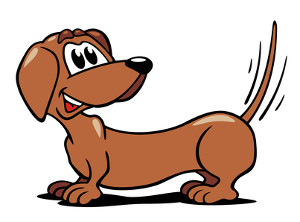
Yes, tail-wagging is often a positive sign, but from the charts above you can also see that different ways, or speed, of wagging can mean different things.
Researchers have now discovered that the direction in which a dog 'wags' also says something about how he's feeling!
When he 'wags', a dog waves his tail back and forth, and often he 'wags' his entire rear end.
A study undertaken at the Center for Mind/Brain Sciences, at the University of Trento in Italy, found that when a dog wags favoring his left side brain activity shows that he's often feeling anxious, worried or upset.
But when he wags favoring his right, studies of his brain show that he's usually feeling calm, relaxed and happy.
This is a instinctively understood by other dogs, who 'read' the emotions in the tail wag with ease. Interesting stuff huh?
About Dog Behavior & Communication
Although dogs don't speak our language, they communicate with each other in a lot of different ways.
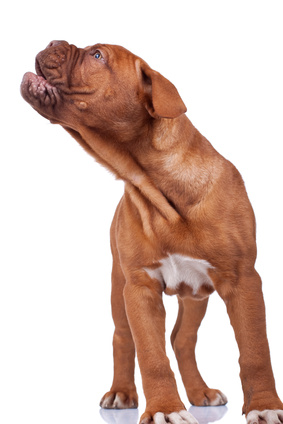
If you want to know how to understand your dog, it helps to learn what each behavior/sound means to a dog.
If you take the time to learn what certain sounds, actions and postures mean you'll soon be 'speaking dog' and that's a big step towards avoiding many of the most common, and sometimes biggest, problems and frustrations of dog ownership.
Here are some clues to what your dog might be trying to tell you......
Vocalizations
Although speaking dog doesn't include real words, the sounds your dog makes all have meaning, and can be one of the easiest actions to understand.
We all know dogs bark, but they also howl, growl, snarl, whine, yelp, whimper and 'grumble'. If you want to understand what your dog is trying to tell you, then you need to know what each type of vocalization usually means...
barking
This can mean your dog is happy or excited, be an attempt to get your attention, give you a warning that a stranger is at the front door, or send a message to another dog in the neighbors yard.
Barking that is designed to get your attention, or as part of a game is usually higher pitched than what you'll hear when you're dog is sounding the 'intruder alert'.
Dogs who are left alone for long periods or get bored can take up barking, just for fun or to keep themselves busy. This is never fun for anyone else.
Click here to learn more.
growling
This can be your dog's way of warning you that he's feeling irritated or angry, and if you ignore him the next step could be a nip/bite. He can also growl in play or for fun.
If he's playing, the growling will most likely be higher-pitched and maybe more 'throaty' than a warning growl which is usually very low, deep and comes from the chest.
A dog can growl without changing his facial expression much at all.
snarling
Snarling is different from growling and is usually a clear indication that a dog is feeling angry and/or aggressive.
The sound is accompanied by pulled back lips which show both teeth and gums, and deep wrinkles extending the length of the muzzle.
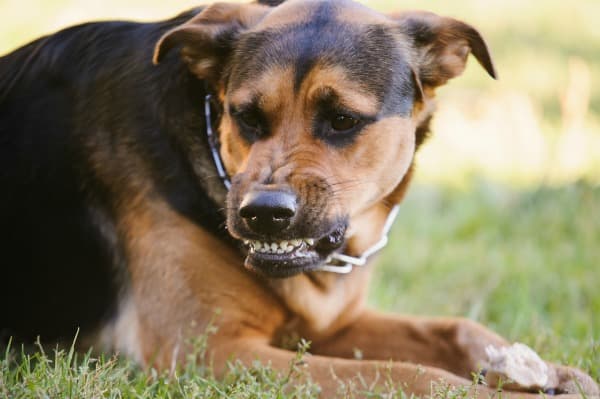
whining
Although dogs of all ages will whine from time to time, it's more common and seen most often in puppies. Pups and dogs whine for pretty much the same reasons human children and adults do.
They want something they can't have, and are upset about it! If your pup whines for a toy, treat or attention and you give it to him you're simply proving to him that this strategy works, so don't do it.
The exception to this is when your pup/dog is whining at the door because he needs to go outside to pee or poop!
howling
This isn't a vocalization that dogs use a whole lot, although some breeds tend to be bigger 'howlers' than others. Hounds of all types are more prone to making this noise than many other breeds. They also 'bay' which is a sound somewhere between howling and barking.
In the wild howling is used as a long-distance communication system and for identifying different packs and groups.
If your pet dog starts to howl he might be bored or lonely, or he may have heard another dog howling. It's a kind of group activity and seems to be contagious (in the same kind of way that yawning is contagious although obviously much noisier).
A siren, car alarm or certain musical instruments can also trigger howling.
grumbling
The best way to describe what this sounds like is 'grumbling'. It's usually a low, rumbling noise and your dog might use it to show that he's irritated, or as 'back-talk' when you tell him off.
In these situations it's not exactly growling, and is milder and less threatening. BUT you should never allow your dog's complaints to control your behavior, or allow him to 'sass' you - a quiet, but firm, verbal correction will show him that you don't approve.
Some breeds tend to 'grumble' or 'groan' when they're feeling content, especially if they're being petted or loved on. Rottweilers are very big on doing this but many other breeds also do it, and individual personality also plays a big role.
This can sound menacing, especially in a big dog, but it's more akin to a cat purring than a growl. However, do be sure that it IS grumbling that a dog is doing and not growling before you carry on with whatever is triggering the noise.
yelping or whimpering
Yelping is a noise most dogs only make when they're in pain, frightened or upset.
Puppies learn bite inhibition (how hard they can bite without fear of retaliation or causing real damage) by nipping and biting each other in play - only stopping when the other puppy yelps.
A yelp of pain is like us saying 'Ouch!'
Some breeds can yelp at the slightest hurt, others have a high tolerance for pain and rarely complain.
Some breeds have a very high-pitched bark that can sound almost like yelping, especially very tiny dogs and some herding dogs.
Whimpering is also a way for a dog to let you know he's in pain or is scared. A yelp is often the first sound and is sudden and sharp, it may be followed by whimpering which is similar to a human crying.
Actions Speak Louder Than Words!
So far we've taken a look at your dog's efforts to communicate with you, and hopefully you now have a better understanding of what he's saying (verbally or otherwise).
But this isn't enough. In order to fully understand your dog it's also very important to understand why he feels or acts a certain way

Dogs rely on body language and behavior more than on vocalizations when they're interacting with other dogs, humans are more into words than actions. This is where the problems can begin!
Wolves (and wild dogs) are pack animals, and in order for the pack to thrive there have to be:
- A set of rules which are obeyed
- A leader who is respected
- Every dog has to know his place/position in the pack
Domesticated dogs still have those instincts hard-wired into their brains and if you want your 'pack' (ie your family) to function properly you need to help your dog figure out where he fits in, who is in charge, and what the rules are.
Of course our dogs are our 'babies' but they're still 100% canine, and it's a huge mistake to expect them to share our human emotions, desires and understanding.
If you treat your pup like a human then you're going to be surprised, irritated, frustrated or confused when he acts like a dog instead of a human.. and that's not his fault... so from day one remember your pup is a canine and work with his instincts and needs.
It will make life so much easier for everyone. So let's take it a step further and see what actions we need to take to make sure that we are speaking the same language as our pup....
Here are the basics of what your dog needs from you:
- A nutritious diet
- Protection from the elements
- Good health
- A leader to follow and respect
- Clear boundaries and house-rules
- A predictable routine
- Lots of love and loving discipline
- Enough exercise and mental stimulation
This list is my own personal thoughts and after decades of experience raising and living with dogs I think it's pretty accurate.
The places where many new owners go wrong, and where miscommunication begins, is with leadership and boundaries. Or lack thereof.
Your puppy's first instinct is to stay with his pack, preferably as close to his momma as possible. This is why when you bring him home he pretty much super-glue's himself to your side... and why he gets so upset when you're out of sight.
As soon as he starts to feel at home and secure he will start looking for the pack leader, and it's important that he realizes this is YOU. Dogs who don't have a clear pack leader they can respect tend to take on the role themselves, and that's not going to end well.
To be seen as the leader you don't need to be harsh, dictatorial or bossy. All you need to do is be calm and firm, and to make sure you set up the rules you want to be followed from day one, and gently but lovingly insist that your pup follows them.
- It's best not to allow a pup/dog to get up onto the furniture, or sleep in your bed, until he's firmly established in the right position in the pack (read 'family') hierarchy.
- Don't allow him to guard his food or possessions from ANY human.
- Never allow growling or snapping at people and discourage biting/nipping (which is a normal puppy behavior but one he has to learn is not acceptable any more).
- Start training your pup at home, and also enroll him in a formal obedience class as soon as he's old enough and fully vaccinated.
- Make sure he gets plenty of positive, ongoing socialization experiences so that he learns how to act around different people and pets and in a variety of situations and environments.
- Never allow your pup/dog to control your behavior with his... eg. don't stop doing something because he objects to it, don't pet him because he demands it, don't give in to whining and so on.
- Use training methods and corrections that he understands and whenever possible use his canine instincts to help him learn quickly.....
Crate training works in tandem with a dog's natural desire not to mess where he sleeps and that's why it's such an effective house training technique.
Giving a pup a quick (but not rough) shake by the scruff of his neck along with a verbal 'no' is an effective correction for misbehavior because his doggie momma would do the same thing.
Use his innate need for routine and repetition, and the speed with which dogs pick up new habits to help him learn obedience commands and behaviors... consistency and repetition are the keys.
mixed signals or incorrect assumptions
Dogs don't express love in the same way we do, they don't have the same understanding of right and wrong, or feel guilt or try to 'get even' with another dog (or even a person).
When we overlay human emotions onto our pet's abilities misunderstandings are bound to happen.....

- You might think giving your pooch a bear-hug is an expression of love, a dog may see it as a show of dominance.
- The same goes for a long, lingering look into your dog's eyes, reaching over his head to pet him, or stroking him firmly from head to tail.
- To us all of these are expressions of affection, to dogs they are all attempts at dominance.
Your own dog should accept these without complaint, even if he doesn't reciprocate, but try them on a strange dog at your own risk!
- Then there's the opposite side of the coin......
- Your dog is always lying right on top of your feet, or leaning heavily against your legs, you take this to mean that he loves you so much that he doesn't want to leave your side.
While it's possible that IS what your dog is 'saying', it's more likely that he's trying to show you that he's the dominant one by his very basic (but strangely effective) attempt to reduce your mobility!
Lying across open doorways or in narrow halls or common traffic paths in your home sends the same message, so does forcing himself into you lap and towering over you! - If your dog gets whiny and pushy when you're on the phone, talking to someone else, or paying attention to another pet, he's trying to control your behavior and is demanding your attention. It may be cute and make you feel loved, but if you let him drag your attention back to him, then your dog feels that he's in control.
- When your puppy or dog keeps jumping up at your face and trying to lick it when he's greeting you, he's not aiming to give you a kiss he's showing you respect. Licking the muzzle of the pack leader, or elder/more senior dogs is the canine version of a salute or bow.
Other behaviors that often need a bit of extra translation include....
- When your adolescent, un-neutered male pup starts to spray urine all over the furniture, house, yard, even other pets or (gasp!) you, then he's not lost all bladder control, he's simply scent-marking.
This is a dog's way of marking out his territory and showing other dogs that he is the King of this particular castle!
Neutering your dog before he's sexually mature should prevent this behavior from ever starting up. - If you have a pup who's naturally a bit anxious or shy, and he always pees on the floor when a visitor comes near him, or men talk to him, or you raise your voice and so on, this isn't a house training problem.
It's most likely submissive urination which is a completely instinctive reflex action that many puppies have, especially those who are nervous, shy, or anxious. It's his way of saying 'I'm scared and I know that you're the big boss' - and he simply can't control it.
Shouting, smacking or any other type of punishment will only make him pee more because he'll think he wasn't clear first time around! - Naturally submissive dogs also tend to have a default setting which makes them roll over onto their backs and display their bellies upward. This is not just a plea to tickle their tummies, it's a sign that your dog is recognizing your leadership and authority.
- There are all sorts of behaviors your dog might exhibit if he's feeling unwell. Apart from the obvious ones such as digestive upsets, developing a limp, blood loss or yelping in pain, there are other clues.
Puppies or dogs who are sick, in pain or distressed often pace, pant, drool, shake or whimper... maybe just one of these, or maybe three, four or all of them. A dog who sleeps all the time (if that's not usual for him) may also be in trouble. - A dog who is unsure of himself or nervous often yawns repeatedly.
- If you're on a road trip and your dog is drooling and licking his lips, he's feeling nauseous and is likely to vomit soon.
Related pages............
you might also like...
- Home
- Puppy Behavior
- How to Understand Your Dog
FTC Disclosure: Some pages on this site contain affiliate links. I may earn on qualified purchases.
